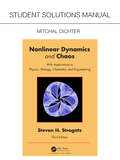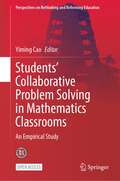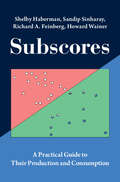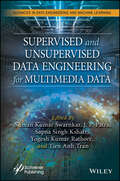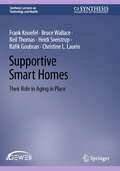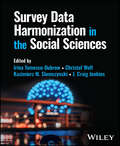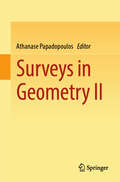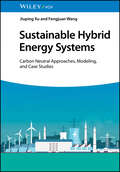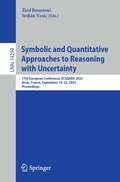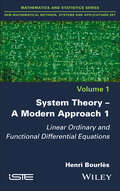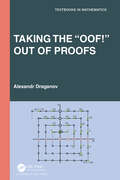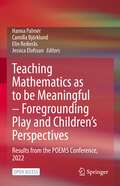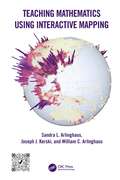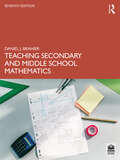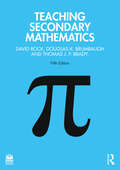- Table View
- List View
Student Solutions Manual for Non Linear Dynamics and Chaos: With Applications to Physics, Biology, Chemistry, and Engineering
by Mitchal DichterThis official Student Solutions Manual includes solutions to the odd-numbered exercises featured in the third edition of Steven Strogatz's classic text Nonlinear Dynamics and Chaos: With Applications to Physics, Biology, Chemistry, and Engineering. The textbook and accompanying Student Solutions Manual are aimed at newcomers to nonlinear dynamics and chaos, especially students taking a first course in the subject. Complete with graphs and worked-out solutions, this manual demonstrates techniques for students to analyze differential equations, bifurcations, chaos, fractals, and other subjects Strogatz explores in his popular book.
Student Solutions Manual for Non Linear Dynamics and Chaos: With Applications to Physics, Biology, Chemistry, and Engineering
by Mitchal DichterThis official Student Solutions Manual includes solutions to the odd-numbered exercises featured in the third edition of Steven Strogatz's classic text Nonlinear Dynamics and Chaos: With Applications to Physics, Biology, Chemistry, and Engineering. The textbook and accompanying Student Solutions Manual are aimed at newcomers to nonlinear dynamics and chaos, especially students taking a first course in the subject. Complete with graphs and worked-out solutions, this manual demonstrates techniques for students to analyze differential equations, bifurcations, chaos, fractals, and other subjects Strogatz explores in his popular book.
Students’ Collaborative Problem Solving in Mathematics Classrooms: An Empirical Study (Perspectives on Rethinking and Reforming Education)
by Yiming CaoThis open access book provides key insights into the social fundamentals of learning and indications of social interactive modes conducive and restrictive of that learning in China. Combining theoretical and technical advances in an innovative research design, this book focuses on collaborative problem solving in mathematics to increase the visibility of social interactions in teachers’ designing, students’ learning and teachers’ instructional intervention. It also explores students’ cognitive and social interaction as well as teacher intervention in students’ group collaboration.
Subscores: A Practical Guide to Their Production and Consumption
by null Shelby Haberman null Sandip Sinharay null Richard A. Feinberg null Howard WainerThis authoritative guide directs consumers and users of test scores on when and how to provide subscores and how to make informed decisions based on them. The book is designed to be accessible to practitioners and score users with varying levels of technical expertise, from executives of testing organizations and students who take tests to graduate students in educational measurement, psychometricians, and test developers. The theoretical background required to evaluate subscores and improve them are provided alongside examples of tests with subscores to illustrate their use and misuse. The first chapter covers the history of tests, subtests, scores, and subscores. Later chapters go into subscore reporting, evaluating and improving the quality of subscores, and alternatives to subscores when they are not appropriate. This thorough introduction to the existing research and best practices will be useful to graduate students, researchers, and practitioners.
Supervised and Unsupervised Data Engineering for Multimedia Data
by Suman Kumar Swarnkar J. P. Patra Sapna Singh Kshatri Yogesh Kumar Rathore Tien Anh TranSUPERVISED and UNSUPERVISED DATA ENGINEERING for MULTIMEDIA DATA Explore the cutting-edge realms of data engineering in multimedia with Supervised and Unsupervised Data Engineering for Multimedia Data, where expert contributors delve into innovative methodologies, offering invaluable insights to empower both novices and seasoned professionals in mastering the art of manipulating multimedia data with precision and efficiency. Supervised and Unsupervised Data Engineering for Multimedia Data presents a groundbreaking exploration into the intricacies of handling multimedia data through the lenses of both supervised and unsupervised data engineering. Authored by a team of accomplished experts in the field, this comprehensive volume serves as a go-to resource for data scientists, computer scientists, and researchers seeking a profound understanding of cutting-edge methodologies. The book seamlessly integrates theoretical foundations with practical applications, offering a cohesive framework for navigating the complexities of multimedia data. Readers will delve into a spectrum of topics, including artificial intelligence, machine learning, and data analysis, all tailored to the challenges and opportunities presented by multimedia datasets. From foundational principles to advanced techniques, each chapter provides valuable insights, making this book an essential guide for academia and industry professionals alike. Whether you’re a seasoned practitioner or a newcomer to the field, Supervised and Unsupervised Data Engineering for Multimedia Data illuminates the path toward mastery in manipulating and extracting meaningful insights from multimedia data in the modern age.
Supervised and Unsupervised Data Engineering for Multimedia Data
by Suman Kumar Swarnkar J P Patra Sapna Singh Kshatri Yogesh Kumar Rathore Tien Anh TranSUPERVISED and UNSUPERVISED DATA ENGINEERING for MULTIMEDIA DATA Explore the cutting-edge realms of data engineering in multimedia with Supervised and Unsupervised Data Engineering for Multimedia Data, where expert contributors delve into innovative methodologies, offering invaluable insights to empower both novices and seasoned professionals in mastering the art of manipulating multimedia data with precision and efficiency. Supervised and Unsupervised Data Engineering for Multimedia Data presents a groundbreaking exploration into the intricacies of handling multimedia data through the lenses of both supervised and unsupervised data engineering. Authored by a team of accomplished experts in the field, this comprehensive volume serves as a go-to resource for data scientists, computer scientists, and researchers seeking a profound understanding of cutting-edge methodologies. The book seamlessly integrates theoretical foundations with practical applications, offering a cohesive framework for navigating the complexities of multimedia data. Readers will delve into a spectrum of topics, including artificial intelligence, machine learning, and data analysis, all tailored to the challenges and opportunities presented by multimedia datasets. From foundational principles to advanced techniques, each chapter provides valuable insights, making this book an essential guide for academia and industry professionals alike. Whether you’re a seasoned practitioner or a newcomer to the field, Supervised and Unsupervised Data Engineering for Multimedia Data illuminates the path toward mastery in manipulating and extracting meaningful insights from multimedia data in the modern age.
Supportive Smart Homes: Their Role in Aging in Place (Synthesis Lectures on Technology and Health)
by Frank Knoefel Bruce Wallace Neil Thomas Heidi Sveistrup Rafik Goubran Christine L. LaurinSignificant health-industry human resource needs increase the reliance on family and friends to support older adults hoping to age in place. This book explores how recent improvements in integrated home technologies have the potential to address those challenges. The book considers how embedded home sensors can be used to monitor the health and wellbeing of older adults and how that can be used to assist with supporting safety and well-being. The content is designed to help multiple stakeholders in the supportive smart home space to better understand the complexity of this field and the need for transdisciplinary collaboration. These stakeholders include the older adults who will benefit from supportive smart home technology; informal and formal caregiver and healthcare professionals concerned about the older adult’s well-being; researchers from multiple disciplines in the supportive smart home area and their funders; companies looking to develop solutions and services or expand their offerings; policy makers who want to ensure privacy and equity in access and a successful integration of these technologies into the evolving health and social services sectors; and students, the future leaders in AgeTech. Overall, the intent of the book is to inspire engineers, computer scientists, industrial designers, clinicians and healthcare providers, social scientists, students, policy makers, and older adults and their caregivers to collaborate in advancing the supportive smart home space to develop more options for aging in place.
Survey Data Harmonization in the Social Sciences
by Irina Tomescu-Dubrow Christof Wolf Kazimierz M. Slomczynski J. Craig JenkinsSurvey Data Harmonization in the Social Sciences An expansive and incisive overview of the practical uses of harmonization and its implications for data quality and costs In Survey Data Harmonization in the Social Sciences, a team of distinguished social science researchers delivers a comprehensive collection of ex-ante and ex-post harmonization methodologies in the context of specific longitudinal and cross-national survey projects. The book examines how ex-ante and ex-post harmonization work individually and in relation to one another, offering practical guidance on harmonization decisions in the preparation of new data infrastructure for comparative research. Contributions from experts in sociology, political science, demography, economics, health, and medicine are included, all of which give voice to discipline-specific and interdisciplinary views on methodological challenges inherent in harmonization. The authors offer perspectives from Europe and the United States, as well as Africa, the latter of which provides insights rarely featured in survey research methodology handbooks. Readers will also find: A thorough introduction to approaches and concepts for survey data harmonization, as well as the effects of data harmonization on the overall survey research process Comprehensive explorations of ex-ante harmonization of survey instruments and non-survey data Practical discussions of ex-post harmonization of national social surveys, census and time use data, including explorations of survey data recycling A detailed overview of statistical issues linked to the use of harmonized survey data Perfect for upper undergraduate and graduate researchers who specialize in survey methodology, Survey Data Harmonization in the Social Sciences will also earn a place in the libraries of survey practitioners who engage in international research.
Survey Data Harmonization in the Social Sciences
by Irina Tomescu‐Dubrow Christof Wolf Kazimierz M. Slomczynski J. Craig JenkinsSurvey Data Harmonization in the Social Sciences An expansive and incisive overview of the practical uses of harmonization and its implications for data quality and costs In Survey Data Harmonization in the Social Sciences, a team of distinguished social science researchers delivers a comprehensive collection of ex-ante and ex-post harmonization methodologies in the context of specific longitudinal and cross-national survey projects. The book examines how ex-ante and ex-post harmonization work individually and in relation to one another, offering practical guidance on harmonization decisions in the preparation of new data infrastructure for comparative research. Contributions from experts in sociology, political science, demography, economics, health, and medicine are included, all of which give voice to discipline-specific and interdisciplinary views on methodological challenges inherent in harmonization. The authors offer perspectives from Europe and the United States, as well as Africa, the latter of which provides insights rarely featured in survey research methodology handbooks. Readers will also find: A thorough introduction to approaches and concepts for survey data harmonization, as well as the effects of data harmonization on the overall survey research process Comprehensive explorations of ex-ante harmonization of survey instruments and non-survey data Practical discussions of ex-post harmonization of national social surveys, census and time use data, including explorations of survey data recycling A detailed overview of statistical issues linked to the use of harmonized survey data Perfect for upper undergraduate and graduate researchers who specialize in survey methodology, Survey Data Harmonization in the Social Sciences will also earn a place in the libraries of survey practitioners who engage in international research.
Surveys in Geometry II
by Athanase PapadopoulosThe book is the second volume of a collection which consists of surveys that focus on important topics in geometry which are at the heart of current research. The topics in the present volume include the conformal and the metric geometry of surfaces, Teichmüller spaces, immersed surfaces of prescribed extrinsic curvature in 3-dimensional manifolds, symplectic geometry, the metric theory of Grassmann spaces, homogeneous metric spaces, polytopes, the higher-dimensional Gauss–Bonnet formula, isoperimetry in finitely generated groups and Coxeter groups.Each chapter is intended for graduate students and researchers. Several chapters are based on lectures given by their authors to middle-advanced level students and young researchers. The whole book is intended to be an introduction to important topics in geometry.
Sustainable Hybrid Energy Systems: Carbon Neutral Approaches, Modeling, and Case Studies
by Jiuping Xu Fengjuan WangSustainable Hybrid Energy Systems Discovering comprehensive approaches to build sustainable hybrid energy systems Hybridization is the eternal theme of human energy utilization. However, it has never been more important than it is now because of the urgency of promoting energy transition and achieving carbon neutrality. Therefore, exploring the design, combustion, operation, and policy challenges of sustainable hybrid energy systems becomes increasingly important. Sustainable Hybrid Energy Systems: Carbon Neutral Approaches, Modeling, and Case Studies provides a detailed explanation of these aspects. Dividing hybrid energy systems into three categories—co-located, co-combusted, and co-operated, this book emphasizes the deployment optimization, emission quota allocation, scheduling coordination, and renewable portfolio standards implementation of these systems. The results are essential tools for understanding the current and future of multi-input single-output hybrid energy systems. Sustainable Hybrid Energy Systems readers will also find: Clear logical framework that reveals the constitutes of hybrid energy systems.Systematic technical scheme for building an economic, environmental, flexible, and resilient future energy system.Extensive case studies from single power plant level, multiple power plant level, and grid level.Effective guidelines for wider application of the proposed carbon neutral approaches. Sustainable Hybrid Energy Systems is ideal for power engineers, electrical engineers, scientists in industry, and environmental researchers looking to understand these energy solutions. It will also provide collectible value for libraries.
Sustainable Hybrid Energy Systems: Carbon Neutral Approaches, Modeling, and Case Studies
by Jiuping Xu Fengjuan WangSustainable Hybrid Energy Systems Discovering comprehensive approaches to build sustainable hybrid energy systems Hybridization is the eternal theme of human energy utilization. However, it has never been more important than it is now because of the urgency of promoting energy transition and achieving carbon neutrality. Therefore, exploring the design, combustion, operation, and policy challenges of sustainable hybrid energy systems becomes increasingly important. Sustainable Hybrid Energy Systems: Carbon Neutral Approaches, Modeling, and Case Studies provides a detailed explanation of these aspects. Dividing hybrid energy systems into three categories—co-located, co-combusted, and co-operated, this book emphasizes the deployment optimization, emission quota allocation, scheduling coordination, and renewable portfolio standards implementation of these systems. The results are essential tools for understanding the current and future of multi-input single-output hybrid energy systems. Sustainable Hybrid Energy Systems readers will also find: Clear logical framework that reveals the constitutes of hybrid energy systems.Systematic technical scheme for building an economic, environmental, flexible, and resilient future energy system.Extensive case studies from single power plant level, multiple power plant level, and grid level.Effective guidelines for wider application of the proposed carbon neutral approaches. Sustainable Hybrid Energy Systems is ideal for power engineers, electrical engineers, scientists in industry, and environmental researchers looking to understand these energy solutions. It will also provide collectible value for libraries.
Sustained Simulation Performance 2022: Proceedings of the Joint Workshop on Sustained Simulation Performance, High-Performance Computing Center Stuttgart (HLRS), University of Stuttgart and Tohoku University, May and October 2022
by Michael M. Resch Wolfgang Bez Hiroaki Kobayashi Hiroyuki Takizawa Johannes GebertThis book presents the state of the art in High-Performance Computing on modern supercomputer architectures. It addresses trends in hardware and software development in general. The contributions cover a broad range of topics, from performance evaluations in context with power efficiency to Computational Fluid Dynamics and High-Performance Data Analytics. In addition, they explore new topics like the use of High-Performance Computers in the field of Artificial Intelligence and Machine Learning. All contributions are based on selected papers presented in 2022 at the 33rd Workshop on Sustained Simulation Performance, WSSP33, held at HLRS in Stuttgart, Germany, and WSSP34, held at Tohoku University in Sendai, Japan.
Symbolic and Quantitative Approaches to Reasoning with Uncertainty: 17th European Conference, ECSQARU 2023, Arras, France, September 19–22, 2023, Proceedings (Lecture Notes in Computer Science #14294)
by Zied Bouraoui Srdjan VesicThis book constitutes the refereed proceedings of the 17th European Conference on Symbolic and Quantitative Approaches to Reasoning with Uncertainty, ECSQARU 2023, held in Arras, France, in September 2023. The 35 full papers presented in this volume were carefully reviewed and selected from 46 submissions. The papers are organized in topical sections about Complexity and Database Theory; Formal Concept Analysis: Theoretical Advances; Formal Concept Analysis: Applications; Modelling and Explanation; Semantic Web and Graphs; Posters.
System Theory -- A Modern Approach, Volume 1: Linear Ordinary and Functional Differential Equations
by Henri BourlèsThe theory of dynamic systems is addressed in this book in accordance with the “modern” approach, heir to algebraic analysis, which has been implemented since the last decade of the 20th century. After a reminder of the evolution of the representation of systems based on transfer functions or matrices, the duality of controllability and observability is revisited, and new results are produced concerning time-varying discrete-time systems. To complete and improve the existing analyses, the poles and zeros of linear systems and their interconnections are presented in a new way, as well as the problem of systems governed by functional differential equations (of retarded or neutral type) and their stabilization. This book also proposes known and original mathematical complements.
System Theory -- A Modern Approach, Volume 1: Linear Ordinary and Functional Differential Equations
by Henri BourlèsThe theory of dynamic systems is addressed in this book in accordance with the "modern" approach, heir to algebraic analysis, which has been implemented since the last decade of the 20th century. After a reminder of the evolution of the representation of systems based on transfer functions or matrices, the duality of controllability and observability is revisited, and new results are produced concerning time-varying discrete-time systems. To complete and improve the existing analyses, the poles and zeros of linear systems and their interconnections are presented in a new way, as well as the problem of systems governed by functional differential equations (of retarded or neutral type) and their stabilization. This book also proposes known and original mathematical complements.
Taking the “Oof!” Out of Proofs (Textbooks in Mathematics)
by Alexandr DraganovThis book introduces readers to the art of doing mathematical proofs. Proofs are the glue that holds mathematics together. They make connections between math concepts and show why things work the way they do. This book teaches the art of proofs using familiar high-school concepts, such as numbers, polynomials, functions, and trigonometry. It retells math as a story, where the next chapter follows from the previous one.Readers will see how various mathematical concepts are tied and will see that mathematics is not a pile of formulas and facts; rather, it has an orderly and beautiful edifice.The author begins with basic rules of logic and then progresses through the topics already familiar to the students: numbers, inequalities, functions, polynomials, exponents, and trigonometric functions. There are also beautiful proofs for conic sections, sequences, and Fibonacci numbers. Each chapter has exercises for the reader.Reviewer Comments:I find the book very impressive. The choice and sequence of topics is excellent, and it is wonderful to have all of these things together in one volume. Theorems are clearly stated, and proofs are accurate. – Michael ComenetzThe thoroughness of the narrative is one of the main strengths of the book. The book provides a perfect illustration of mathematical thinking. Each step of a given derivation is precise and clear. – Julie GershunskayaDraganov’s book stands out from the many competing books. Draganov’s goal is to show that mathematics depends on the notion of proof. Unlike other transition books, he addresses mathematical topics at an accessible level, rather than topics studied later in the university curriculum. – Ken Rosen
Taking the “Oof!” Out of Proofs: A Primer On Mathematical Proofs (Textbooks in Mathematics)
by Alexandr DraganovThis book introduces readers to the art of doing mathematical proofs. Proofs are the glue that holds mathematics together. They make connections between math concepts and show why things work the way they do. This book teaches the art of proofs using familiar high-school concepts, such as numbers, polynomials, functions, and trigonometry. It retells math as a story, where the next chapter follows from the previous one.Readers will see how various mathematical concepts are tied and will see that mathematics is not a pile of formulas and facts; rather, it has an orderly and beautiful edifice.The author begins with basic rules of logic and then progresses through the topics already familiar to the students: numbers, inequalities, functions, polynomials, exponents, and trigonometric functions. There are also beautiful proofs for conic sections, sequences, and Fibonacci numbers. Each chapter has exercises for the reader.Reviewer Comments:I find the book very impressive. The choice and sequence of topics is excellent, and it is wonderful to have all of these things together in one volume. Theorems are clearly stated, and proofs are accurate. – Michael ComenetzThe thoroughness of the narrative is one of the main strengths of the book. The book provides a perfect illustration of mathematical thinking. Each step of a given derivation is precise and clear. – Julie GershunskayaDraganov’s book stands out from the many competing books. Draganov’s goal is to show that mathematics depends on the notion of proof. Unlike other transition books, he addresses mathematical topics at an accessible level, rather than topics studied later in the university curriculum. – Ken Rosen
Tax Avoidance Research: Exploring Networks and Dynamics of Global Academic Collaboration (SIDREA Series in Accounting and Business Administration)
by Antonio De Vito Francesco GrossettiThis book explores the intricate realm of tax avoidance, synthesizing existing empirical literature in the field. The work starts by exploring the theoretical underpinnings of tax avoidance, dissecting its unique features compared to tax evasion. It delves into measurement methodologies and dissects the determinants contributing to its prevalence. Moreover, it analyzes the economic consequences of tax avoidance, emphasizing its impact on critical accounting issues, including financial reporting transparency, cost of capital, and firm value. Next, the book offers a foundational understanding of graph theory, unveiling the core elements of networks, such as nodes and edges. The book covers the theoretical fundamentals and addresses the practical side of constructing networks based on real-world relational systems. It emphasizes the importance of effective data collection and representation methods and underscores the importance of optimizing network layouts for enhanced visual representation. Using network analysis, the book further offers a deep dive into empirical studies on tax avoidance over the past two decades, revealing insights into the collaborative nature of this stream of research. Finally, the book summarizes the key insights of the network analysis on tax avoidance. It underscores the dynamic nature of individual authors' roles and affiliations, shedding light on the collaborative dynamics within institutions.
Teaching Mathematics as to be Meaningful – Foregrounding Play and Children’s Perspectives: Results from the POEM5 Conference, 2022
by Hanna Palmér Camilla Björklund Elin Reikerås Jessica ElofssonThis open access book’s theme is Teaching mathematics as to be meaningful – foregrounding children’s play and perspectives. It discusses the relation between teachers, children and mathematical content within the context of play with a particular focus on the framing of these relations within this context, which is an important theme in the debate on whether teaching should be integrated with or separated from children’s play. The work further addresses meaningfulness in the learning process, particularly from the child’s perspective. Globally, most guidelines and curricula for early childhood education mention play as one of the key features for young children’s learning. Still, there are quite different views on the definitions of play and in what ways play should become part of children’s learning. The chapters of the book mirror the research topics presented at the fifth POEM conference in May 2022 divided into four sub-themes: Play and learning, Children’s perspectives on mathematics, Teachers’ competencies and Theorizing aspects of early mathematics education.
Teaching Mathematics Using Interactive Mapping
by Sandra L. Arlinghaus Joseph J. Kerski William C. ArlinghausTeaching Mathematics Using Interactive Mapping offers novel ways to learn basic math topics such as simple relational measures or measuring hierarchies through customized interactive mapping activities. These activities focus on interactive web-based Geographic Information System (GIS) and are relevant to today’s problems and challenges. Written in a guided, hands-on, understandable manner, all activities are designed to build practical and problem-solving skills that rest on mathematical principles and move students from thinking about maps as references that focus solely on "where is" something, to analytical tools, focusing primarily on the "whys of where." Success with this transition through interaction permits most readers to master mathematical concepts and GIS tools. FEATURES Offers custom-designed geographical activities to fit with specific mathematical topics Helps students become comfortable using mathematics in a variety of professions Provides an innovative, engaging, and practical set of activities to ease readers through typically difficult, often elementary, mathematical topics: fractions, the distributive law, and much more Uses web-based GIS maps, apps, and other tools and data that can be accessed on any device, anywhere, at any time, requiring no prior GIS background Written by experienced teachers and researchers with lifelong experience in teaching mathematics, geography, and spatial analysis This textbook applies to undergraduate and graduate students in universities and community colleges including those in basic mathematics courses, as well as upper-level undergraduate and graduate students taking courses in geographic information systems, remote sensing, photogrammetry, geography, geodesy, information science, engineering, and geology. Professionals interested in learning techniques and technologies for collecting, analyzing, managing, processing, and visualizing geospatial datasets will also benefit from this book as they refresh their knowledge in mathematics.
Teaching Mathematics Using Interactive Mapping
by Sandra L. Arlinghaus Joseph J. Kerski William C. ArlinghausTeaching Mathematics Using Interactive Mapping offers novel ways to learn basic math topics such as simple relational measures or measuring hierarchies through customized interactive mapping activities. These activities focus on interactive web-based Geographic Information System (GIS) and are relevant to today’s problems and challenges. Written in a guided, hands-on, understandable manner, all activities are designed to build practical and problem-solving skills that rest on mathematical principles and move students from thinking about maps as references that focus solely on "where is" something, to analytical tools, focusing primarily on the "whys of where." Success with this transition through interaction permits most readers to master mathematical concepts and GIS tools. FEATURES Offers custom-designed geographical activities to fit with specific mathematical topics Helps students become comfortable using mathematics in a variety of professions Provides an innovative, engaging, and practical set of activities to ease readers through typically difficult, often elementary, mathematical topics: fractions, the distributive law, and much more Uses web-based GIS maps, apps, and other tools and data that can be accessed on any device, anywhere, at any time, requiring no prior GIS background Written by experienced teachers and researchers with lifelong experience in teaching mathematics, geography, and spatial analysis This textbook applies to undergraduate and graduate students in universities and community colleges including those in basic mathematics courses, as well as upper-level undergraduate and graduate students taking courses in geographic information systems, remote sensing, photogrammetry, geography, geodesy, information science, engineering, and geology. Professionals interested in learning techniques and technologies for collecting, analyzing, managing, processing, and visualizing geospatial datasets will also benefit from this book as they refresh their knowledge in mathematics.
Teaching Secondary and Middle School Mathematics
by Daniel J. BrahierTeaching Secondary and Middle School Mathematics combines the latest developments in research, technology, and standards with a vibrant writing style to help teachers prepare for the excitement and challenges of teaching secondary and middle school mathematics. The book explores the mathematics teaching profession by examining the processes of planning, teaching, and assessing student progress through practical examples and recommendations. Beginning with an examination of what it means to teach and learn mathematics, the reader is led through the essential components of teaching, concluding with an examination of how teachers continue with professional development throughout their careers. Hundreds of citations are used to support the ideas presented in the text, and specific websites and other resources are presented for future study by the reader. Classroom scenarios are presented to engage the reader in thinking through specific challenges that are common in mathematics classrooms. The seventh edition has been updated and expanded with particular emphasis on the latest technology, standards, and other resources. The reader is introduced to the ways that students think and how to best meet their needs through planning that involves attention to differentiation, as well as how to manage a classroom for success. Features include: • Following on from the sixth edition, assessment takes a central role in planning and teaching. Unit 3 (of 5) addresses the use of summative and formative assessments to inform classroom teaching practices. • A new appendix is included that lists websites that can be used in a methods class to view other teachers interacting with students for discussion of effective teaching practices. • The feature entitled “Links and Resources” has been updated in each of the 13 chapters. Five strongly recommended and practical resources are spotlighted at the end of each chapter as an easy reference to some of the most important materials on the topic. • Approximately 150 new citations have either replaced or been added to the text to reflect the latest in research, materials, and resources that support the teaching of mathematics. • Significant revisions have been made to Chapter 12, which now includes updated research and practices as well as a discussion on culturally responsive pedagogy. Likewise, Chapter 8 now includes a description of best and high-leverage teaching practices, and a discussion in Chapter 11 on alternative high school mathematics electives for students has been added. • Chapter 9, on the practical use of classroom technology, has again been revised to reflect the latest tools available to classroom teachers, including apps that can be run on handheld personal devices, in light of changes in education resulting from the global pandemic. An updated Instructor’s Manual features a test bank, sample classroom activities, PowerPoint slide content, chapter summaries, and learning outcomes for each chapter, and can be accessed by instructors online at www.routledge.com/9781032472867.
Teaching Secondary and Middle School Mathematics
by Daniel J. BrahierTeaching Secondary and Middle School Mathematics combines the latest developments in research, technology, and standards with a vibrant writing style to help teachers prepare for the excitement and challenges of teaching secondary and middle school mathematics. The book explores the mathematics teaching profession by examining the processes of planning, teaching, and assessing student progress through practical examples and recommendations. Beginning with an examination of what it means to teach and learn mathematics, the reader is led through the essential components of teaching, concluding with an examination of how teachers continue with professional development throughout their careers. Hundreds of citations are used to support the ideas presented in the text, and specific websites and other resources are presented for future study by the reader. Classroom scenarios are presented to engage the reader in thinking through specific challenges that are common in mathematics classrooms. The seventh edition has been updated and expanded with particular emphasis on the latest technology, standards, and other resources. The reader is introduced to the ways that students think and how to best meet their needs through planning that involves attention to differentiation, as well as how to manage a classroom for success. Features include: • Following on from the sixth edition, assessment takes a central role in planning and teaching. Unit 3 (of 5) addresses the use of summative and formative assessments to inform classroom teaching practices. • A new appendix is included that lists websites that can be used in a methods class to view other teachers interacting with students for discussion of effective teaching practices. • The feature entitled “Links and Resources” has been updated in each of the 13 chapters. Five strongly recommended and practical resources are spotlighted at the end of each chapter as an easy reference to some of the most important materials on the topic. • Approximately 150 new citations have either replaced or been added to the text to reflect the latest in research, materials, and resources that support the teaching of mathematics. • Significant revisions have been made to Chapter 12, which now includes updated research and practices as well as a discussion on culturally responsive pedagogy. Likewise, Chapter 8 now includes a description of best and high-leverage teaching practices, and a discussion in Chapter 11 on alternative high school mathematics electives for students has been added. • Chapter 9, on the practical use of classroom technology, has again been revised to reflect the latest tools available to classroom teachers, including apps that can be run on handheld personal devices, in light of changes in education resulting from the global pandemic. An updated Instructor’s Manual features a test bank, sample classroom activities, PowerPoint slide content, chapter summaries, and learning outcomes for each chapter, and can be accessed by instructors online at www.routledge.com/9781032472867.
Teaching Secondary Mathematics
by David Rock Douglas K. Brumbaugh Thomas J. BradySolidly grounded in up-to-date research, theory, and technology, Teaching Secondary Mathematics is a practical, student-friendly, and popular text for secondary mathematics methods courses. It provides clear and useful approaches for mathematics teachers and shows how concepts typically found in a secondary mathematics curriculum can be taught in a positive and encouraging way. The thoroughly revised fifth edition combines this pragmatic approach with truly innovative and integrated technology content throughout. Synthesized content between the book and a comprehensive Instructor and Student Resource website offers expanded discussion of chapter topics, additional examples, and technological tips, such as using and assessing artificial intelligence.Each chapter features tried-and-tested pedagogical techniques, problem-solving challenges, discussion points, activities, mathematical challenges, and student-life-based applications that will encourage students to think and do.New to the fifth edition: A fully revised chapter on technological advancements in the teaching of mathematics, including the use of artificial intelligence A new chapter on equity, shame, and anxiety in the mathematics classroom Connections to both the updated National Council of Teachers of Mathematics (NCTM) Focal Points and Standards Problem-solving challenges and sticky questions featured in each chapter to encourage students to think through everyday issues and possible solutions A fresh interior design to better highlight pedagogical elements and key features A completely updated Instructor and Student Resource site with chapter-by-chapter video lessons, teacher tools, problem solving Q&As, exercises, and helpful links and resources.
